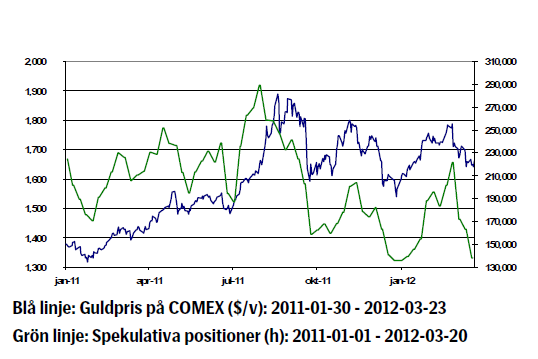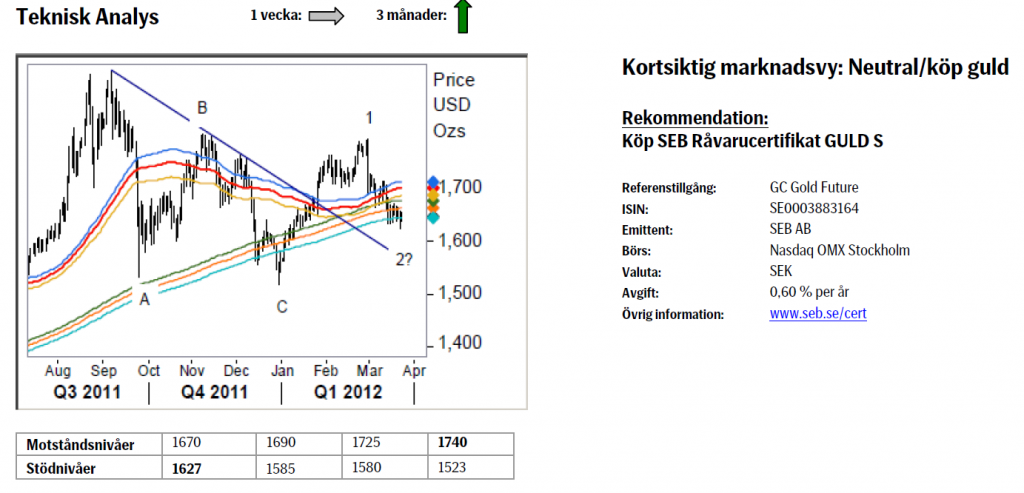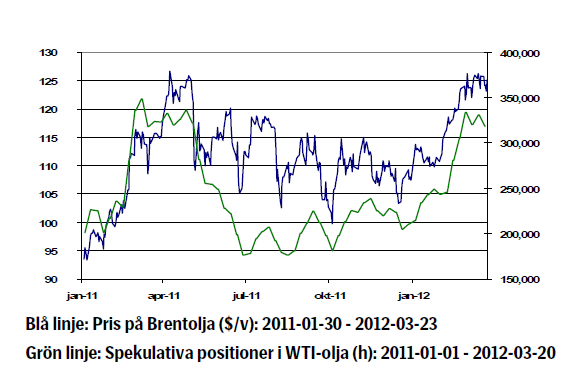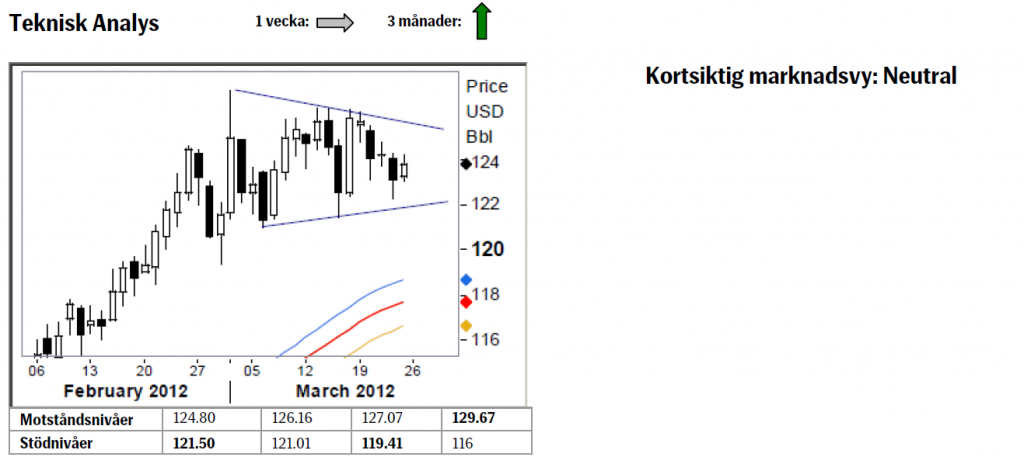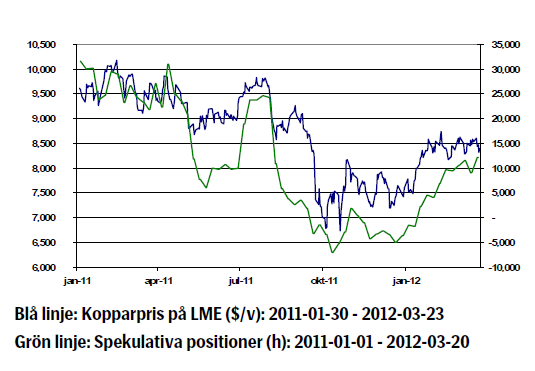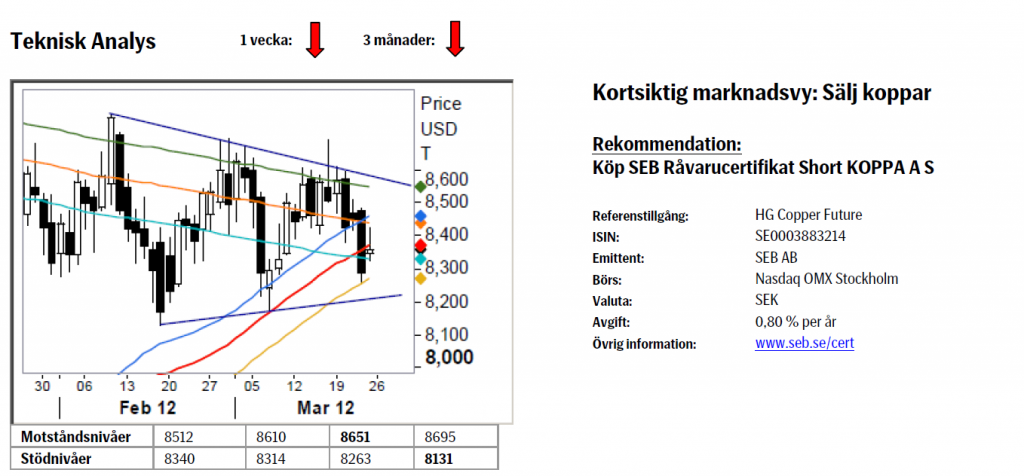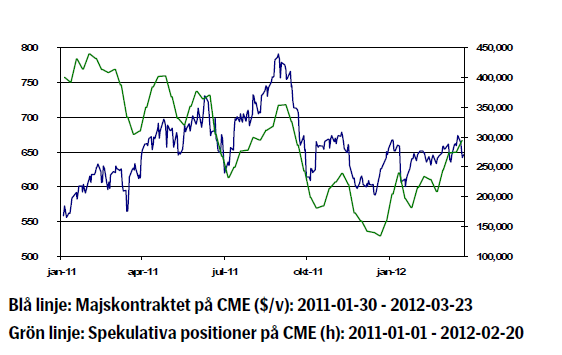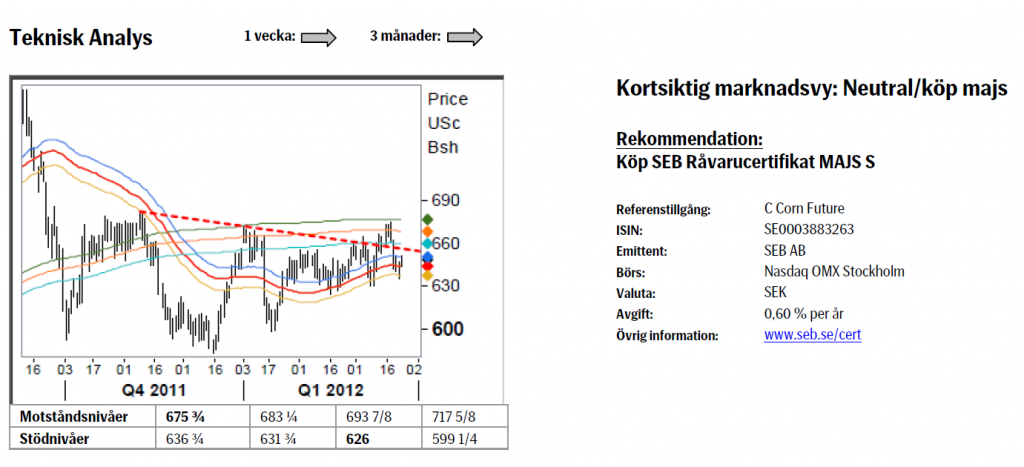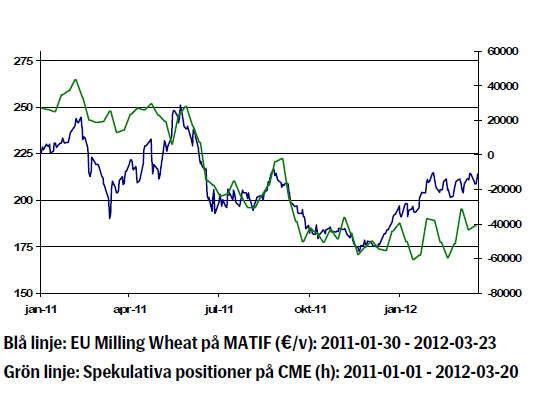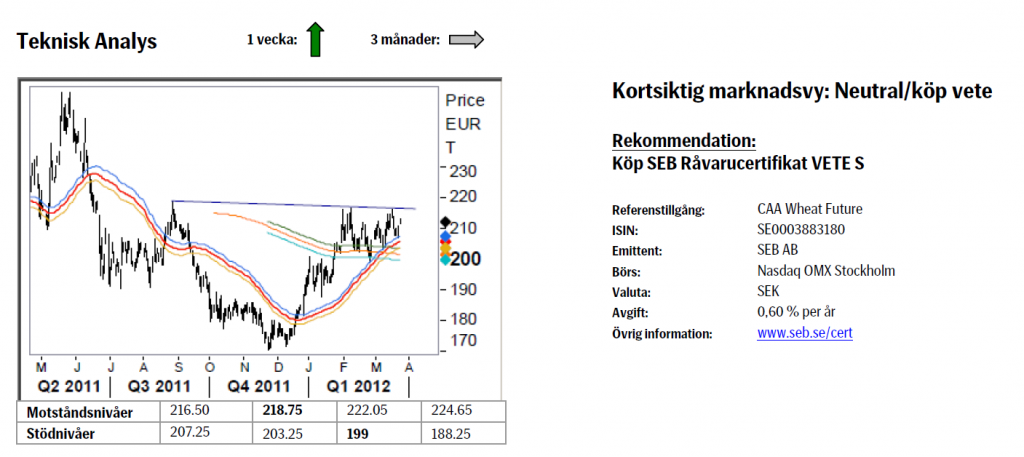Analys
SEB – Råvarukommentarer vecka 13 2012
Sammanfattning: Föregående vecka
- Brett råvaruindex: -1,33 %
UBS Bloomberg CMCI TR Index - Energi: -0,91 %
UBS Bloomberg CMCI Energy TR Index - Ädelmetaller: +0,11 %
UBS Bloomberg CMCI Precious Metals TR Index - Industrimetaller: -2,67 %
UBS Bloomberg CMCI Industrial Metals TR Index - Jordbruk: -0,92 %
UBS Bloomberg CMCI Agriculture TR Index
Kortsiktig marknadsvy:
- Guld: Neutral/köp
- Olja: Neutral
- Koppar: Sälj
- Majs: Neutral/köp
- Vete: Neutral/köp
Guld
- Det grekiska parlamentet godkände på onsdagen formellt det sparpaket som var förutsättningen för ett andra räddningspaket från EU och IMF. Detta var mest en formalitet men beskedet gav stöd åt euron. Denna föll emellertid igen på torsdagen då inköpsprisindex från Tyskland var sämre än förväntat. Dollarn steg och råvaror sjönk brett. Italiens premiärminister Monti varnade i helgen för att Spanien skulle kunna utlösa en ny allvarlig kris i EMU och uppmanade landet att ta kontroll över sin statsbudget. Oron för en recession i Europa ökar.
- Guldet föll totalt 6,5 procent förra veckan. Innehavare av fysiska ETF:er minskade sina innehav och världens största guld-ETF, SPDR Gold Trust, tappade 8 ton guld.
- Från den första april i år inför Indien en fyraprocentig importskatt på guld, en åtgärd som har lett till att landets 300 000 juvelerare nu strejkar. Indien är det land i världen som importerar störst mängd guld.
- Vi bedömer att guldpriset på kort sikt sannolikt inte kommer att kunna gå undernuvarande nivåer. Vid eventuella bakslag i den globala återhämtningen kan dock priset komma upp något igen. Med detta som bakgrund förhåller vi oss svagt positiva till guldpriset denna vecka.
- Teknisk Analys: Under den senaste veckan har marknaden i princip varje dag handlat ned under 233-dagarsbandet bara för att när dagen är slut ha återvänt in i det. Beteendet visar på kontinuerligt köpande i området och framför allt torsdagens kursrörelse indikerar att säljarna nu tappat kraft. Följaktligen fortsätter vi rekommendera försiktiga köp i området (över 1725/40 mer aggressivt då vi då kan bekräfta vändningen uppåt).
Olja
- Oljepriset föll totalt med 0,5 procent förra veckan, men i fredags steg Brentpriset plötsligt tre dollar efter en rapport från Petrologistics att oljeexporten från Iran väntas sjunka betydligt i mars. Råoljeexporten från Iran verkar falla med 300 000 fat olja per dag vilket motsvarar cirka tio procent av landets totala export.
- Bränslekostnader i Kina, vilka styrs direkt av kinesiska myndigheter, har höjts. Detta för att rädda landets raffinaderier vilka köper olja på rörligt pris men slutprodukter till fast pris. Detta medför i dagsläget ekonomiska problem för dem och bidrog till att oljepriset föll då man räknar med att efterfrågan minskar. Kina är världens näst största oljekonsument.
- Trots att det för tillfället inte råder någon brist på olja i marknaden så fortsätter oron kring Iran att ge stöd åt priset och rykten och nyheter gör att priset snabbt kan stiga. En hög riskpremie finns med andra ord kvar i marknaden. Både Bernanke och Obama har uttryckt oro för att oljepriset kommer att ligga kvar på nuvarande höga nivåer. Även i Europa uttrycks oro från politikers håll och Frankrike har annonserat att man överväger att släppa lös strategiska oljereserver. USA utövar påtryckningar på Kina och Indien att de ska minska oljeimporten från Iran, för att på så sätt undgå sanktioner från USA. De minskningar som länderna gjort hittills är inte tillräckliga.
- Teknisk Analys: Vår vy är sedan förra veckan helt oförändrad och kommer att så förbli tills antingen vi bryter upp ur triangeln bekräftandes vår vy om en ny topp i 129-131-området alternativt bryter ned under 121,50, vilket skulle göra triangeln obsolet och då snarare peka på en toppformation (såsom det ju eventuellt ser ut att bli i fallet koppar).Teknisk Analys: I och med brottet över aprilkontraktets tidigare topp förstärks uppåt potentialen. Nästa givna mål ska sökas vid 129.75/131.39 området, nästa Fibonacci projektionsområde. Där ovanför återfinns också toppen från 2007, 147.50. Det är dock noterbart att i €uro termer så handlas Brentoljan nu på nya rekordnivåer.
Koppar
- Kopparpriset föll 2,18 procent förra veckan. Det största raset skedde på torsdagen då priset föll till 8262 dollar per ton, det lägsta priset på två år. Inköpsprisindex från Europa och Kina kom in på lägre nivåer än förväntat vilket ökad farhågan i marknaden att efterfrågan på koppar, främst från Kina, kommer att minska.
- Kinesiskt HSBC:s flash-PMI för mars kom in svagare än föregående månad och föll från 49.6 till 48.1, vilket innebär att index nu legat under 50-nivån fem månader i rad. Index för nya ordrar föll och sysselsättningen noterade den lägsta nivån sedan mars 2009. Ett värde under 50 innebär en kontraktion.
- Kinesisk fastighetsmarknad har kylts av något, vilket också varit avsikten med myndigheternas restriktivare penningpolitik. Ytterligare ekonomiska stimulanser är inte troliga för tillfället från kinesiska myndigheters håll, vilket verkar dämpande på kopparpriset.
- Teknisk Analys: Det eventuellt positiva triangelscenario vi skrev om förra veckan har sedan dess tappat mark givet den kraftiga (dock fortsatt inom triangeln) nedgång som skett. Sannolikheten för ett negativt utfall måste därför anses ha ökat och ett test av stödområdet dvs. feb/mar-bottnarna bör ske under nästkommande vecka.
Majs
- Förra veckan började med ett par procents nedgång, detta efter svaga exportsiffror från USA och generella uttag från investerarkollektivet. Enligt CME fanns även viss oro för att det kinesiska majspriset skulle falla tillbaka något från förra veckans rekordnivåer.
- Torsdagens svaga inköpchefsindexsiffror från Europa och Kina satte nedåttryck på råvarupriserna, detta med undantag för jordbrukssektorn. Signaler om en god global efterfrågan och frågetecken kring den kommande majsskörden i Nord- och Sydamerika tryckte exempelvis majspriset uppåt. Med andra ord var tendenserna de omvända jämfört med den första halvan av veckan.
- Vidare gick en statlig kinesisk nyhetskanal i torsdags ut med indikationer om ett växande underskott av majs de kommande åren. Även om denna typ av utspel inte påverkar priset direkt ökar den generella efterfrågan och kan på så sätt ge kortsiktigt stöd åt priset.
- Denna vecka håller vi ögonen på Argentina, där både majs och sojabönor har fått visst stöd uppåt av landets försämrade produktionsutsikter. Vi bibehåller med detta vår kortsiktigt svagt positiva syn.
- Teknisk Analys: Uppenbarligen ropade vi hej lite för tidigt förra veckan. Brottet över trendlinjen fick aldrig sin givna fortsättning, ett brott av 233-dagarsbandet och följaktligen tröttnande snart köparna och stängde en lång position. Så vi är nu tillbaka på ruta ett i det neutrala området mellan medelvärdesbanden.
Vete
- Precis som majs och sojabönor gick vetet svagt under första halvan av veckan, där framförallt investerare valde att minska andelen jordbruksråvaror i portföljerna. De gynnsamma regn som föll i de vintervetesproducerande delarna av USA förstärkte denna rörelse ytterligare.
- Även om vetepriset i Chicago återhämtade sig något under torsdagen och fredagen var det ingenting mot den rörelse vi kunde se i Paris, där priset under denna period steg med drygt 2,5 procent och innebar en knapp uppgång jämfört med veckan innan.
- Enligt analysfirman DTN väntas den kommande veckan bli ovanligt torr i stora delar av Europa, vilket kan påverka den nuvarande skörden av vintervete. Denna oro får anses vara central för den starka avslutningen förra veckan.
- Under februari månad spekulerades det en hel del kring huruvida den ryska skörden av vintervete skulle bli väsentligen sämre än vad marknaden tidigare hade förväntat sig. Det extremt kalla vädret gjorde att risken för omfattande produktionsbortfall (som en konsekvens av frostskador) ansågs vara stor. Enligt Bloomberg har nu ryska spannmålsorgan kunnat bekräfta att bortfallet inte är så stort som man befarat.
- Med den förväntade torkan i Europa som starkaste argument förhåller vi oss fortsatt svagt positiva till vetepriset på MATIF.
- Teknisk Analys: Konsolideringen ovanför medelvärdesbanden har fortsatt även den senaste veckan. Vår förväntan är att vi kommer att bryta upp över topplinjen vilken vecka som helst och att ett sådant brott i sinom tur bör kunna utlösa en rörelse upp emot majtoppen från förra året. Bara ett överraskande brott under 199 förändrar ovanstående vy.
[box]SEB Veckobrev Veckans råvarukommentar är producerat av SEB Merchant Banking och publiceras i samarbete och med tillstånd på Råvarumarknaden.se[/box]
Disclaimer
The information in this document has been compiled by SEB Merchant Banking, a division within Skandinaviska Enskilda Banken AB (publ) (“SEB”).
Opinions contained in this report represent the bank’s present opinion only and are subject to change without notice. All information contained in this report has been compiled in good faith from sources believed to be reliable. However, no representation or warranty, expressed or implied, is made with respect to the completeness or accuracy of its contents and the information is not to be relied upon as authoritative. Anyone considering taking actions based upon the content of this document is urged to base his or her investment decisions upon such investigations as he or she deems necessary. This document is being provided as information only, and no specific actions are being solicited as a result of it; to the extent permitted by law, no liability whatsoever is accepted for any direct or consequential loss arising from use of this document or its contents.
About SEB
SEB is a public company incorporated in Stockholm, Sweden, with limited liability. It is a participant at major Nordic and other European Regulated Markets and Multilateral Trading Facilities (as well as some non-European equivalent markets) for trading in financial instruments, such as markets operated by NASDAQ OMX, NYSE Euronext, London Stock Exchange, Deutsche Börse, Swiss Exchanges, Turquoise and Chi-X. SEB is authorized and regulated by Finansinspektionen in Sweden; it is authorized and subject to limited regulation by the Financial Services Authority for the conduct of designated investment business in the UK, and is subject to the provisions of relevant regulators in all other jurisdictions where SEB conducts operations. SEB Merchant Banking. All rights reserved.
Analys
OPEC+ in a process of retaking market share

Oil prices are likely to fall for a fourth straight year as OPEC+ unwinds cuts and retakes market share. We expect Brent crude to average USD 55/b in Q4/25 before OPEC+ steps in to stabilise the market into 2026. Surplus, stock building, oil prices are under pressure with OPEC+ calling the shots as to how rough it wants to play it. We see natural gas prices following parity with oil (except for seasonality) until LNG surplus arrives in late 2026/early 2027.

Oil market: Q4/25 and 2026 will be all about how OPEC+ chooses to play it
OPEC+ is in a process of unwinding voluntary cuts by a sub-group of the members and taking back market share. But the process looks set to be different from 2014-16, as the group doesn’t look likely to blindly lift production to take back market share. The group has stated very explicitly that it can just as well cut production as increase it ahead. While the oil price is unlikely to drop as violently and lasting as in 2014-16, it will likely fall further before the group steps in with fresh cuts to stabilise the price. We expect Brent to fall to USD 55/b in Q4/25 before the group steps in with fresh cuts at the end of the year.

Natural gas market: Winter risk ahead, yet LNG balance to loosen from 2026
The global gas market entered 2025 in a fragile state of balance. European reliance on LNG remains high, with Russian pipeline flows limited to Turkey and Russian LNG constrained by sanctions. Planned NCS maintenance in late summer could trim exports by up to 1.3 TWh/day, pressuring EU storage ahead of winter. Meanwhile, NE Asia accounts for more than 50% of global LNG demand, with China alone nearing a 20% share (~80 mt in 2024). US shale gas production has likely peaked after reaching 104.8 bcf/d, even as LNG export capacity expands rapidly, tightening the US balance. Global supply additions are limited until late 2026, when major US, Qatari and Canadian projects are due to start up. Until then, we expect TTF to average EUR 38/MWh through 2025, before easing as the new supply wave likely arrives in late 2026 and then in 2027.
Analys
Manufacturing PMIs ticking higher lends support to both copper and oil

Price action contained withing USD 2/b last week. Likely muted today as well with US closed. The Brent November contract is the new front-month contract as of today. It traded in a range of USD 66.37-68.49/b and closed the week up a mere 0.4% at USD 67.48/b. US oil inventory data didn’t make much of an impact on the Brent price last week as it is totally normal for US crude stocks to decline 2.4 mb/d this time of year as data showed. This morning Brent is up a meager 0.5% to USD 67.8/b. It is US Labor day today with US markets closed. Today’s price action is likely going to be muted due to that.

Improving manufacturing readings. China’s manufacturing PMI for August came in at 49.4 versus 49.3 for July. A marginal improvement. The total PMI index ticked up to 50.5 from 50.2 with non-manufacturing also helping it higher. The HCOB Eurozone manufacturing PMI was a disastrous 45.1 last December, but has since then been on a one-way street upwards to its current 50.5 for August. The S&P US manufacturing index jumped to 53.3 in August which was the highest since 2022 (US ISM manufacturing tomorrow). India manufacturing PMI rose further and to 59.3 for August which is the highest since at least 2022.
Are we in for global manufacturing expansion? Would help to explain copper at 10k and resilient oil. JPMorgan global manufacturing index for August is due tomorrow. It was 49.7 in July and has been below the 50-line since February. Looking at the above it looks like a good chance for moving into positive territory for global manufacturing. A copper price of USD 9935/ton, sniffing at the 10k line could be a reflection of that. An oil price holding up fairly well at close to USD 68/b despite the fact that oil balances for Q4-25 and 2026 looks bloated could be another reflection that global manufacturing may be accelerating.
US manufacturing PMI by S&P rose to 53.3 in August. It was published on 21 August, so not at all newly released. But the US ISM manufacturing PMI is due tomorrow and has the potential to follow suite with a strong manufacturing reading.
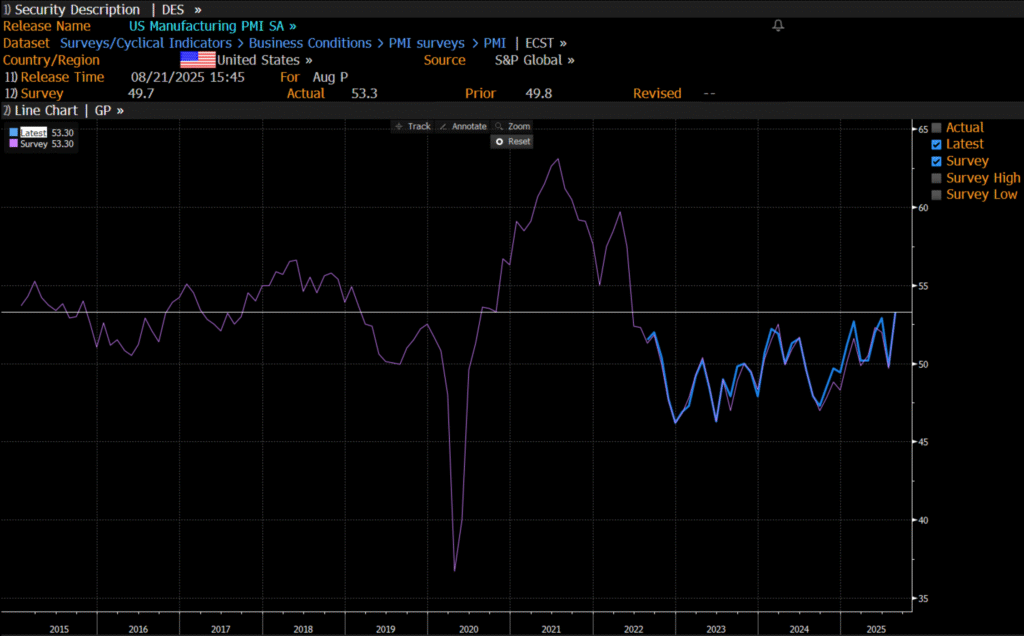
Analys
Crude stocks fall again – diesel tightness persists

U.S. commercial crude inventories posted another draw last week, falling by 2.4 million barrels to 418.3 million barrels, according to the latest DOE report. Inventories are now 6% below the five-year seasonal average, underlining a persistently tight supply picture as we move into the post-peak demand season.

While the draw was smaller than last week’s 6 million barrel decline, the trend remains consistent with seasonal patterns. Current inventories are still well below the 2015–2022 average of around 449 million barrels.
Gasoline inventories dropped by 1.2 million barrels and are now close to the five-year average. The breakdown showed a modest increase in finished gasoline offset by a decline in blending components – hinting at steady end-user demand.
Diesel inventories saw yet another sharp move, falling by 1.8 million barrels. Stocks are now 15% below the five-year average, pointing to sustained tightness in middle distillates. In fact, diesel remains the most undersupplied segment, with current inventory levels at the very low end of the historical range (see page 3 attached).
Total commercial petroleum inventories – including crude and products but excluding the SPR – fell by 4.4 million barrels on the week, bringing total inventories to approximately 1,259 million barrels. Despite rising refinery utilization at 94.6%, the broader inventory complex remains structurally tight.
On the demand side, the DOE’s ‘products supplied’ metric – a proxy for implied consumption – stayed strong. Total product demand averaged 21.2 million barrels per day over the last four weeks, up 2.5% YoY. Diesel and jet fuel were the standouts, up 7.7% and 1.7%, respectively, while gasoline demand softened slightly, down 1.1% YoY. The figures reflect a still-solid late-summer demand environment, particularly in industrial and freight-related sectors.


-
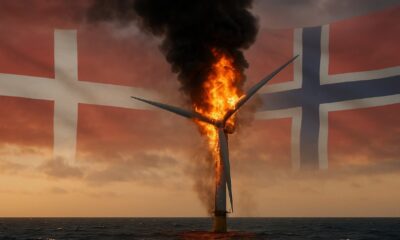
 Nyheter3 veckor sedan
Nyheter3 veckor sedanOmgående mångmiljardfiasko för Equinors satsning på Ørsted och vindkraft
-
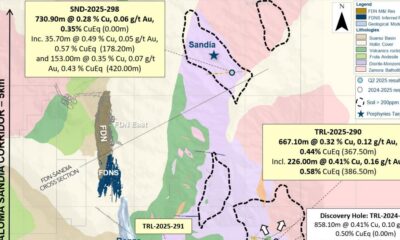
 Nyheter4 veckor sedan
Nyheter4 veckor sedanLundin Gold hittar ny koppar-guld-fyndighet vid Fruta del Norte-gruvan
-

 Nyheter2 veckor sedan
Nyheter2 veckor sedanMeta bygger ett AI-datacenter på 5 GW och 2,25 GW gaskraftverk
-

 Nyheter4 veckor sedan
Nyheter4 veckor sedanGuld stiger till över 3500 USD på osäkerhet i världen
-

 Analys3 veckor sedan
Analys3 veckor sedanWhat OPEC+ is doing, what it is saying and what we are hearing
-

 Nyheter2 veckor sedan
Nyheter2 veckor sedanAker BP gör ett av Norges största oljefynd på ett decennium, stärker resurserna i Yggdrasilområdet
-

 Nyheter4 veckor sedan
Nyheter4 veckor sedanLyten, tillverkare av litium-svavelbatterier, tar över Northvolts tillgångar i Sverige och Tyskland
-

 Analys2 veckor sedan
Analys2 veckor sedanBrent sideways on sanctions and peace talks



